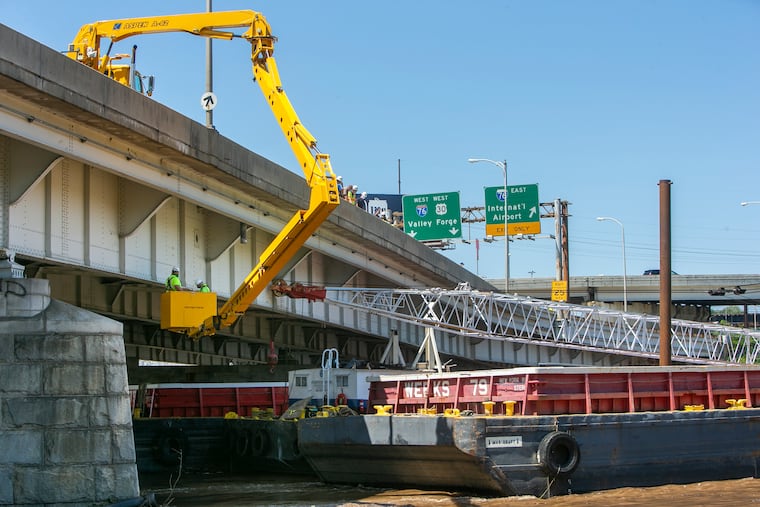Ida remnants threaten Philly with first significant Delaware River flooding in 10 years, forecasters say
River flooding is "likely," the National Weather Service says, and an "isolated tornado" is possible south and east of I-95.

What is left of the erstwhile Hurricane Ida’s remnants is forecast to track close to Philadelphia, threatening the region with widespread heavy rains and perhaps the most significant flooding along the Delaware River in 10 years, forecasters are warning.
All of eastern Pennsylvania and New Jersey and Delaware are under a flash flood watch, starting at 8 a.m. Wednesday and continuing until 2 p.m. Thursday, with the potential for up to 6 inches of rain in some areas.
“River flooding is likely,” said Brian Haines, science and operations officer at the National Weather Service Office in Mount Holly. The weather service said in its evening briefing that “moderate to major” flooding was possible.
“If you’re by a river, now is the time to get ready,” he said. In addition, the weather service said, south and east of I-95 an “isolated tornado” is possible.
On Tuesday, although computer models still were disagreeing it was looking more likely that the axis of the heaviest rain would be somewhere near Philadelphia
“This isn’t our first rodeo,” said Jason Bobst, manager and emergency-management director in flood-prone West Norriton Township, in Montgomery County along the Schuylkill, where preparations were underway Tuesday. But the storm’s potential is more than a cause for concern. “I can’t remember a storm of this magnitude for the area it’s covering,” he said.
Downpours have been hit and miss around here in the last several weeks, and were mostly miss over the weekend. But the official rain gauge at Philadelphia International Airport — known to play a mean game of dodgeball with raindrops — captured 3.17 inches Saturday, a record for Aug. 28.
» READ MORE: The heat from Center City’s buildings and streets might be giving the rains a little extra juice
While the more random thunderstorm and shower outbreaks have been coaxing the jumpier streams out of their banks, this time the National Weather Service has “high confidence” that the coverage will be more widespread, said Nicholas Carr, a lead meteorologist at the Mount Holly office.
And rather than just their tributaries, the main stem of the Schuylkill and the Delaware River might be vulnerable.
Said Delaware River Basin Commission spokesperson Kate Schmidt, “We are watching things closely.”
About Ida
Two days after slamming into the Louisiana coast as a Category 4 hurricane with peak winds of 150 mph, Ida, reduced to a tropical depression, was near the southern Tennessee border late Tuesday morning.
Ida’s primary threat for the rest of its career will be widespread inundating rains as its remnants follow an arcing track that would take the core of them near Philadelphia.
Areas to the north of Philadelphia remain saturated from Henri’s remnants, and soil-moisture levels in the Delaware headwaters are well above normal.
» READ MORE: Thousands face weeks without power in Ida’s aftermath
Carr said the most benign track would be more southerly, south of Philadelphia (sorry, Delaware and extreme South Jersey), targeting areas that haven’t had quite as much rain.
About the Delaware
Some significant flooding occurred along the Schuylkill as a result of the remnants of Isaias last August, but the Delaware has been more flood-resistant.
“We kind of make a joke there that the Delaware doesn’t flood anymore,” said Carr. Save for some nuisance flooding, that has been true for the last decade.
“The Delaware is always a tough nut to crack,” he said.
The river hasn’t gone substantially above flood stage since Tropical Storm Irene’s rains in 2011 engorged the river to 23.11 feet at Trenton, more than 3 feet above flood stage. Significant flooding had occurred in 2006 in late June, in April 2005, and September 2004.
» READ MORE: Fred remnants set off floods in the Philly region, two tornadoes, and whole lot of phone alarms
The Delaware waters just haven’t returned to those “elevated levels” that had it primed for flooding, Carr said. On noon Monday, the river at Trenton was at 10.6 feet.
However, partially from Henri, rainfall from Bucks County to the New York state line along the river has been well above normal in the last 30 days and the soils are quite wet. Rains to the north would increase the flood threat, and Brian Thompson, a senior meteorologist with AccuWeather Inc., said some of those areas could wind up in the heaviest rain bands.
AccuWeather is calling for Philadelphia to be near the 4-inch line, with areas to the south and east receiving less, and the northern and western suburbs up to 6 inches.
Computer models still hadn’t sorted out precisely where the axis of the heaviest rain would fall, but Philadelphia could end up close to the bull’s-eye, and AccuWeather’s Thompson said the axis could shift in either direction.
West Norriton’s Bobst said the township will be ready. On Tuesday the local fire company was readying three boats and a marine rescue vehicle, and crews were clearing storm drains.
“I think we’ll be alright,” he said.